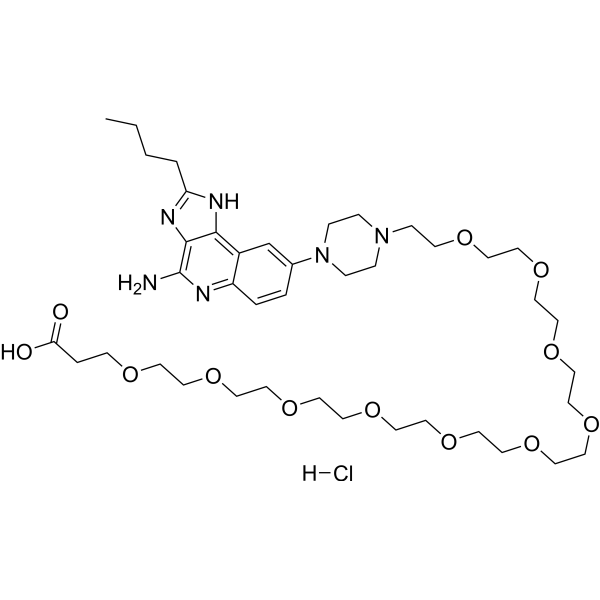| Cas No.: | 2388520-36-1 |
| Chemical Name: | TLR7/8 agonist 4 hydroxy-PEG10-acid hydrochloride |
| Synonyms: | 4,7,10,13,16,19,22,25,28,31-Decaoxatritriacontanoic acid, 33-[4-(4-amino-2-butyl-3H-imidazo[4,5-c]quinolin-8-yl)-1-piperazinyl]-, hydrochloride (1:1) |
| SMILES: | C12NC(CCCC)=NC1=C1C(=NC=2N)C=CC(N2CCN(CCOCCOCCOCCOCCOCCOCCOCCOCCOCCOCCC(=O)O)CC2)=C1.Cl |
| Formula: | C41H69ClN6O12 |
| M.Wt: | 873.47 |
| Purity: | >98% |
| Sotrage: | 2 years -20°C Powder, 2 weeks 4°C in DMSO, 6 months -80°C in DMSO |
| Description: | TLR7/8 agonist 4 hydroxy-PEG10-acid hydrochloride (compound 9) is a drug-linker conjugate for ADC with potent antitumor activity by using TLR7/8 agonist 4, linked via the cleavable ADC linker hydroxy-PEG10-acid. |
| Target: | Traditional Cytotoxic Agents |
| In Vitro: | ADCs are comprised of an antibody to which is attached an ADC cytotoxin through an ADC linker. |
| References: | [1]. Shelley Erin ACKERMAN, et al. Immunoconjugates targeting her2. WO2020190725A1. |

 DC Chemicals' products qualify for U.S. tariff exemptions. We guarantee no price increases due to customs duties and maintain stable supply, continuing to deliver reliable research solutions to our American clients.
DC Chemicals' products qualify for U.S. tariff exemptions. We guarantee no price increases due to customs duties and maintain stable supply, continuing to deliver reliable research solutions to our American clients.





















